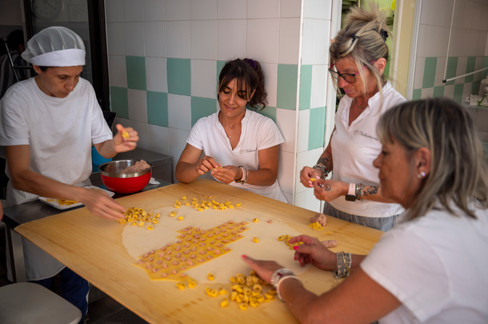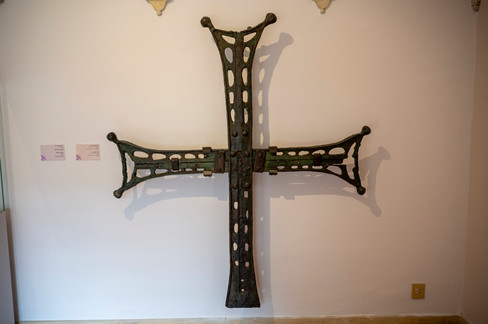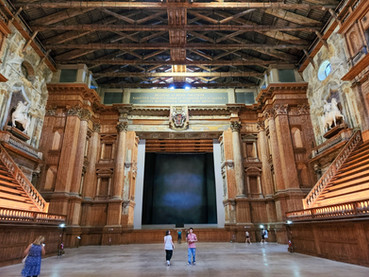Italy - The Emilia-Romagna region. Bologna, Ferrara, Modena, Parma
- Tony
- Jul 3, 2023
- 12 min read
Updated: Nov 16
June 2023
Ask any Italian where their favorite place to eat is and their response will undoubtedly be “Mamma’s kitchen”. But if you ask which region in Italy has the best food, the answer will most likely be Emilia-Romagna.
If you are not familiar with the area you will certainly be familiar with the food that originates from here. Emilia-Romagna is home to culinary specialties that with the mere mention of their name create cravings for some of Italy's finest foods. Parmigiano-Reggiano, Prosciutto de Parma, Culatello, Mortadela, Tortellini, Bolognese, Lasagna, Tagliatelle, and Traditional Balsamic Vinegar, just to name a few.
When planning this trip our main focus was, of course on the food and the opportunity to experience it in its birthplace. Lucky for us and others traveling to the region there is an abundance of spectacular monuments, villages, and towns to explore and activities that require a lot of walking to explore which can help offset some of the additional calorie intake.
We've probably planned too much into the course of this ten-day trip but with so much to see, taste, and do it's really hard to resist packing in as much as we can. This trip includes stays in Bologna, Parma, and Bergamo (which technically isn't part of Emilia-Romagna, it's in the Lombardy region to the north) with day trips to Ferrara, Ravenna, and Modena.
We flew from Faro, Portugal directly to Milan's Bergamo airport on Monday afternoon, about a two-and-a-half-hour flight. We were going to take the train on this trip since Italy has such a great network that can make travel easy but at the last minute we opted to rent a car providing more flexibility for additional touring and keeping the train for a few of the day planned trips. Once we loaded up our Fiat 500x we jumped on the Autostrada for just under three hours driving to our base for the next four nights in Bologna. Since we wouldn't arrive in Bologna until about 10:30 we stopped in a small village near Modena and found a local Trattoria for dinner. Our first food experience which of course included Tagliatelle Bolognese and Tortelloni di ricotta, spinach ai funghi, what a great way to get started! If you love a simple and familiar atmosphere, this is the right place: the Ricchi family has been offering the typical flavors of Modena cuisine for over fifty years:
Bologna, Italy's seventh largest city with just under 400,000 inhabitants with nearly 1/4 of them being students studying at one of the oldest universities in the world (founded in 1088). The blend of tourists and students provides a vibrant atmosphere full of active restaurants and bars, most with 80% of their seating in the streets and alleys. The city has 3 nicknames: la dotta (the learned), la grassa (the fat), and la Rossa (the red). The learned from the large university population, the fat from the amazing foods, and the red representing Bologna's anti-fascist movement during the Second World War, aspects of its ‘red’ culture remain visible today, in street art, and lively student protest culture.
The historic center is a complex web of monuments, churches, food stalls, restaurants, bars, and shops most under the shade of the city's vast number of Porticos, providing the perfect relief from the unusual early summer heat. The porticoes are an inescapable feature of the city, so much so that in 2021 Unesco officially declared Bologna the “City of Porticoes”.
The heart of the city, Piazza Maggiore is the result of centuries-old transformations that gradually enriched it with important monuments: the Basilica of San Petronio, the Palazzo dei Notai, the Palazzo d'Accursio, the Palazzo del Podestà, Palazzo dei Banchi, and the Fountain of Neptune. The week we were there started a summer-long nightly free movie presentation set in the center of the plaza. A large screen and seating for several hundred in front of the Basilica featuring international films and used for graduation ceremonies during the day. We happened to catch a ceremony for graduating Doctores as we were passing through the Piazza.
Wander through the nearby Medieval streets of the Quadrilatero, Bologna's oldest and most fascinating market, shops and restaurants. The streets of Drapperie, pescherie, and orefici: all receiving their name from what could be found in the market stalls and shops of the past.
More sights through the streets of Bolognas historic center including the narrow streets of the former Jewish Ghetto, the Founding headquarters of Maserati, and several churches.
Once boasting over 250 towers throughout the city of Bologna, only a fraction of those exists today as a notable part of the city's architecture. Torre Degli Asinelli and Torre Garisenda were built between 1109 and 1119 and were handed over to the Municipality as early as the following century. Torre Degli is open to adventurers willing to climb its 498 internal steps that lead to the top at a height of 97.02 metres offering spectacular views of the city. Torre Garisenda is different due to its shorter height of 47 metres. It is known for its steep tilt due to unstable ground, so much so that Dante featured it in Canto XXXI of the Inferno. It was lowered for fear of it collapsing during the 14th century and is currently being restored.
Bologna's Archiginnasio palace, built in 1562 has an imposing entrance with a long portico consisting of 30 arches, and two floors around a central courtyard. The two large staircases lead to the upper floor which has 10 classrooms (today the main storage of books for the Library) and two lecture halls located at the ends of the building, one for Artists (now the Reading Room of the Library) and one for Lawyers. The walls of the rooms, the vaults of the staircases and loggias are decorated with ornate carved inscriptions and monuments celebrating the masters (Professors) of the classrooms and thousands of students coat of arms and names. The building ceased its university function in 1803; since 1838 it has housed the Library. On the ground floor, some of the old classrooms are occupied by the Medical and Surgical Society and the Academy of Agriculture.
A Food tour of Bologna Why not! A small group tour inside the Historic center to sample and experience what Bologna has to offer: La Salumeria di Bruno e Franco for Prosciutto di Parma DOP, Mortadella di Bologna IGP, Salame Rosa, Ciccioli, Salame Felino IGP, Culatello di Zibello DOP, and Parmigiano Reggiano DOP 24 months: Il Banco del Pane: Osteria del Sole for eating meats and cheese gathered along the way and a taste of Pignoletto DOC [sparkling white wine] and Sangiovese DOC [still red wine]: Trattoria del Rosso for Tagliatelle with Ragù Bolognese, Tortellini with Cream, Lambrusco DOC [sparkling red wine], and Nocino - walnut liqueur: Drogheria Gilberto for tasting IGP & DOP Balsamic Vinegar from Modena 8-12-25 years: Panificio Paolo Atti & Figli for Torta di Riso - Rice Cake [Secret Dish of Bologna]: Cremeria la Vecchia Stalla for Artisanal Gelato.
Ferrara, A short 30 minute train ride from Bologna is the city of Ferrara known for its UNESCO designation, Renaissance buildings, and close proximity to the Po river and its delta. Significantly less crowded than Bologna it was a nice respite and a lot calmer for touring. We visited the moated Este Castle, complete with dungeons, the Romanesque Ferrara Cathedral (under renovation) with its 3-tiered facade and a marble bell tower, and walked through the older streets.
Ravenna, another small city filled with UNESCO world heritage sites. About an hour and a half train ride from Bologna. Far less crowded and filled with spectacular monuments, amazing mosaics, and rich history as the seat of the Roman Empire in the 5th century and then of Byzantine Italy until the 8th century. We walked throughout the city visiting the Mausoleum of Galla Placidia, the Neonian Baptistery, the Basilica of Sant'Apollinare Nuovo, the Archiepiscopal Chapel, the Church of San Vitale and Dante's Tomb.
Modena, We moved our home base for this portion of our trip slightly north to the town of Parma. Our day trip for today is to the town of Modena, about a 30 minute train ride from Parma. Modena is known as the home of Traditional Balsamic Vinegar, UNESCO sites of the Cathedral, and Ghirlandina Tower, the birthplace of Luciano Pavarotti, top rated restaurants, and the world's 'Supercar Capital', being the nearest large town to the homes of Ferrari (Great Museum) Maserati, Lamborghini, Pagani and previously Ducati and De Tomaso.
We visited the Enzo Ferrari Museum in Modena but were not able to travel out of the city to see the factory and racing museum. The Enzo Museum was very well done telling the story and history of Ferraris founder and his vision. Plenty of fantastic cars on display to drool over and the history of the engines is an amazing tribute to the engineering and attention to detail of the team.
Parma, You may know the name as the home of Parmigiano Reggiano and Prosciutto de Parma but the city has so much more to offer that just ham and cheese (although we could spend days tasting these two)! Parma is a university city of over 400,000 inhabitants that is filled with Romanesque buildings, and inviting pedestrian streets, including the frescoed Parma Cathedral, the pink marble Baptistery, and Piazza Garibaldi that grace the city center.
Yet more stunning frescoes can be seen in the Church of Santa Maria della Staccata behind the Governor's Palace on Piazza Garibaldi, Camera di San Paolo (part of a benedictine monastery), the Church of San Giovanni Evangelista (near the cathedral) and attached monastery which is still operated by monks.
Don't miss the impressive Teatro Farnese, a wooden structured copy of the Palladios Olympic theatre in Vicenza. Part of Parma's extensive Palazzo della Pilotta (Massive Palace) which includes two additional very interesting museums: the National Gallery, and the National Museum of Archaeology, with a wide selection of Roman era artefacts collected in the region around Parma
We highly suggest that you find time to explore the narrow backstreet's of Parma for interesting architecture, monuments, and off the beaten path restaurants and shops.
Borgo del Gazzano. We took a tour out to a small family owned maker of Organic Parmigiano Reggiano. Here we were able to see a closed loop organic farm in action, controlling everything from growing their own feed, raising and milking the cows, and making and aging the cheese that they produce. In the last photo you can see our struggle to fit all the cheese in our suitcases for the trip home to share with friends and neighbors.
Bergamo. For our last two nights we decided to stay in Bergamo so we could spend more time exploring this wonderful city. The airport here is a Milan hub for several regional airlines. I imagine that most people bypass Bergamo as they make their connection into Milan or other cities, missing out on what Bergamo has to offer.
Bergamo is about 45 minutes northeast of Milan and sits along the foothills in the region of Lombardy. The city is divided into two general areas the older hillside called Città Alta, encircled by Venetian walls, and the lower "Bassa" area being the more modern part of the city. For this trip we decided to focus on the Citta Alta.
We stayed at the very top of Citta Alta at the Relais San Vigilio attached to the remaining ruins of the San Vigilio Castle. The Hotel of only 9 rooms is built in the renovated military housing of the castle which dates back to the 6th century. The facilities and gardens are first class, rooms modern but period represented in their design and furnishing, and the views and service were outstanding.
A short walk from the hotel there is a funicular that will take you to and from the Citta Alta just down the hill. The walled city and its cobbled streets are home to shops, restaurants, and monuments. It's home to the Duomo di Bergamo, the city cathedral, the Romanesque Basilica di Santa Maria Maggiore and the grand Cappella Colleoni.
Basilica di Santa Maria Maggiore, piazza del Duomo, Cappella Colleoni, and climb up (or take the convenient elevator) Campanoneto tower in the square and take a look around, surveying the city’s roofs and a landscape that is nothing short of breathtaking.
Where and what we ate along the way
Bologna - Antica Osteria. Traditional specialties, desserts & wines served in an old-fashioned restaurant.
Bologna - La Trattoria Del Tempo Buono - Rustic space with sidewalk tables serving handmade pasta & Mediterranean seafood dishes.
Bologna - Grassilli - Traditional Bolognese dishes & Italian wines in a cozy trattoria lined with photos of opera stars.
Ferrara - Ristorante Pizzeria Osteria Degli Adelardi. We ducked in for a late lunch and need for air-conditioning and were pleased by the quality of the food. Homemade sausage, fresh mushrooms and local craft beer.
Modena- A no frills family run restaurant serving mostly local residents. Homey ambiance like you are dining at grandmas house. Service was straight forward and not overbearing, The food was really good with very traditional offerings
Parma, Poldo Panini. We stopped here for a late lunch after our arrival into Parma. Located across the park from the Palazzo della Pilotta. The menu is a bit quirky and their attempt to offer international meal "Kits" was a bit strange. We tried the Mexican Kit which was not very good for our taste but the greek salad was spot on. After speaking with one of the family members who run the restaurant we learned that they have only been open one week. Seems they all came together after working at other restaurants to open one of their own. The other non-Kit items on the menu looked very good.
Parma, Trattoria Salumeria Sorelle Picchi. In the heart of the active pedestrian streets we sat on the street side terrace where we could enjoy the sights and sounds of the busy nightlife. We were looking for the best Bolognese Lasagna and were recommended to come here. Not disappointed it was absolutely fantastic!
Parma, Trattoria Del Tribunale. Nice setting with outdoor seating. The food was good but the service lacked attention. Our server disappeared, re-assigned to inside tables we think, but no one picked up our table. We had to flag someone down and ask for things like oil and vinegar for our salad and eventually for our entrees. Overall a nice experience though even with the slight inconvenience.
Parma, Fradiavolo Pizzeria. A small chain of Pizzerias that produce very high quality food. The Arancini style fried rice cake with Cacio e Pepe was good. The Black pizza dough option was a first for us, the latest trend in the pizza industry. The dough is blackish, using vegetable charcoal powder and tastes no different than regular pizza dough. Apparently the addition of the charcoal makes the pizza more digestible and is higher in fibre. Either way just another excuse to eat more pizza!
Bergamo, San Vigilio. Ristorante Baretto Next to the top of the Funicular with a great view over the city when dining on the street side terrace. The food and service were very good.
Bergamo, San Vigilio. Ristorante Pizzeria San Vigilio. Fantastic views from the terrace, Food and service were outstanding. Prices are a bit high and the coperta @ 7€ per person was a bit excessive. In any case well worth a visit, you do get great value for what you pay
Bergamo, Citta Alta. Al Donizetti We sat outside for an aperitif but then decided on a light dinner based on our interaction with the staff. Food and drinks were good and we enjoyed the surroundings. Prices are a bit steep for the area including a 7€ per person Coperto which is very high!
Where we stayed
Bologna, Hotel Corona D'oro. Our first four nights were in Bologna at the Hotel Corona D'oro. Rooms and service were very nice, although very pricy during our stay. We really enjoyed our stay here. The location is perfect for exploring the Historic center as it is in the heart of it, a mere four minute walk to the Piazza Maggiore. As with most hotels in the historic centers, access and parking are a bit of a challenge. Arriving late was an experience on its own as we ended up driving on the narrow pedestrian only streets trying to find the hotel. Parking is available in their private garage about a 10 minute walk from the hotel with very small spaces.
Parma, NH Parma Hotel. NH is a large chain/brand in europe and offers mainly mid-scale properties that are generally outside the main tourist areas. This one is a modern Hotel in a convenient location to the train station and Historic center The historic center is about 15 minutes walking from the hotel depending on your destination. The walk between the hotel and historic center can feel a bit sketchy at times but we experienced no problems.Taxi service is also available should you need it. The staff was generally efficient and friendly. Room air conditioning was poor due to the sun exposure. The large windows in the bedroom and bath are appreciated but coverings should be closed by the housekeepers during periods of high heat.
Bergamo, Citta Alta, San Vigilio, Relais San Vigilio. A wonderful boutique hotel with great historic value. Set on the top of the hill in the restored military quarters of the Historic castle, there are only 9 rooms and feels like you are the only guests. Service is outstanding, the views overlooking the city and countryside are breathtaking. The location adjacent to the Funicular is ideal for touring Citta Alta and just a short distance from the lower city. Now one of our favorite hotels!
This was a great trip for us, exploring some of the secondary cities and smaller towns in Italy. Obviously the food was fantastic and the people were warm and welcoming. We were exhausted by the end as a result of packing too much in to one trip. After little travel during Covid and our move to Portugal it seems like our lessons learned from previous travel will need to be dusted off. Since there are so many travel options very near to us now it makes more sense to do shorter trips with a more narrow focus but return more frequently to experience other opportunities.




















































































































































































































































































































































































































































































































































































































































































































































































































































































































Comments